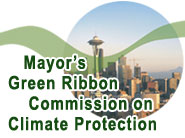 In the fight against global warming, 320 mayors of U.S. cities have boldly gone where the U.S. government would not — into the forefront with 164 nations to embrace the Kyoto Accord and set targets that will lead to reduced greenhouse gas emissions by 2012.
In the fight against global warming, 320 mayors of U.S. cities have boldly gone where the U.S. government would not — into the forefront with 164 nations to embrace the Kyoto Accord and set targets that will lead to reduced greenhouse gas emissions by 2012.
Seattle Mayor Greg Nickels said that even if the federal government did nothing to clean up its act, U.S. mayors could make a difference.
On the day in 2005 when the Kyoto Protocol became law around the world — except in the U.S., where in 2001 President Bush had withdrawn from the treaty — Nickels launched the Climate Protection Initiative and urged heads of other cities to join Seattle in pledging to meet or beat the Kyoto standards, by reducing their heat-trapping gas emissions 7 percent from 1990 levels by 2012.
Seattle was the first to require all its city-owned buildings to be certified green. The buildings, including the new city hall and central library, use less water, less energy and are healthier places to inhabit.
The city’s diesel buses run on veggie oil producing 78 percent fewer greenhouse gas emissions and less air pollution; electric-powered Segways move the meter-reading patrols along Seattle’s streets; its public utility, Seattle City Light, became the first major U.S. electric utility to achieve zero net emissions of greenhouse gases last year.
Big cities like New York, Los Angeles, Chicago and Dallas have signed on to Nickels’ Climate Protection Initiative and they are pooling their best ideas to share with smaller cities, everything from how to enact anti-sprawl land-use policies to how to green the roofs of your buildings.
A report by AP yesterday features all sorts of programs run by U.S. cities trying to meet the Kyoto standards:
Lincoln, Neb., is now running its public buses on biodiesel, has begun operating wind turbines at its electric utility and has established miles of bike and pedestrian trails. Lexington, Ky., has replaced incandescent traffic signal bulbs with more energy-efficient LED ones, added hybrid cars to its municipal fleet and began picking up trash just once a week to trim vehicle emissions. In Salt Lake City, stricter guidelines aimed at making public buildings green have been passed and wind energy is being more widely used. And, many cities have partnered with businesses to meet their goals…



















